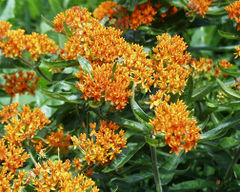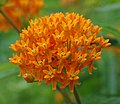Butterfly weed: Difference between revisions
No edit summary |
No edit summary |
||
| (3 intermediate revisions by 2 users not shown) | |||
| Line 1: | Line 1: | ||
{{SPlantbox | {{SPlantbox | ||
|familia=Apocynaceae | |||
|genus=Asclepias | |genus=Asclepias | ||
|species=tuberosa | |species=tuberosa | ||
|common_name=Butterfly Weed | |common_name=Butterfly Weed | ||
|name_ref=Complete Landscaping - ISBN 9780376009272 | |||
|habit=herbaceous | |habit=herbaceous | ||
|habit_ref=Complete Landscaping - ISBN 9780376009272 | |||
|Min ht metric=cm | |Min ht metric=cm | ||
|Max ht box=3 | |Max ht box=3 | ||
|Max ht metric=ft | |Max ht metric=ft | ||
|height_ref=Complete Landscaping - ISBN 9780376009272 | |||
|Max wd box=2 | |Max wd box=2 | ||
|Max wd metric=ft | |Max wd metric=ft | ||
|lifespan=perennial | |lifespan=perennial | ||
|life_ref=Complete Landscaping - ISBN 9780376009272 | |||
|exposure=sun | |exposure=sun | ||
|water=dry | |sun_ref=Complete Landscaping - ISBN 9780376009272 | ||
|water=moderate, dry | |||
|water_ref=Complete Landscaping - ISBN 9780376009272 | |||
|features=flowers, butterflys | |features=flowers, butterflys | ||
|flower_season=early spring, mid spring, late spring, early summer, mid summer, late summer | |flower_season=early spring, mid spring, late spring, early summer, mid summer, late summer | ||
|flowers=orange | |flowers=orange, yellow | ||
|Temp Metric=°F | |Temp Metric=°F | ||
| | |min_zone=4 | ||
|usda_ref=Complete Landscaping - ISBN 9780376009272 | |||
|max_zone=9.5 | |||
|image=Asclepias tuberosa.jpg | |image=Asclepias tuberosa.jpg | ||
|image_width=240 | |image_width=240 | ||
}} | }} | ||
;Common names: <small>Butterfly Weed, Canada Root, Chigger Flower, Chiggerflower, Fluxroot, Indian Paintbrush, Indian Posy, Orange Milkweed, Orange Swallow-wort, Pleurisy Root, Silky Swallow-wort, Tuber Root, Yellow Milkweed, White-root, Windroot</small> | |||
'''Butterfly weed''' (''Asclepias tuberosa'') is a species of [[milkweed]] native to eastern [[North America]]. It is a [[perennial plant]] growing to 0.6-2 m (1 -2 feet) tall, with clustered orange or yellow [[flower]]s from early summer to early fall. The [[leaf|leaves]] are spirally arranged, lanceolate, 5-12 cm long and 2-3 cm broad. | |||
This plant favors dry, sand or gravel soil, but has also been reported on stream margins. It requires full sun. | |||
The common name comes from the [[butterfly|butterflies]] that are attracted to the plant by its color and its copious production of [[nectar]]. Butterfly weed is also the [[larva]]l food plant of the [[Queen (butterfly)|Queen]] and [[Monarch (butterfly)|Monarch]] butterflies. The butterfly weed grows to be 1-3 feet long. | |||
| | |||
The plant looks similar to the [[Lanceolate milkweed]] (''Asclepias lanceolata''), but is uniquely identified by the larger number of flowers, and the hairy stems that are not milky when broken. It is most commonly found in fields with dry soil. | |||
{{Inc| | |||
Asclepias tuberosa, Linn. Butterfly-weed. Pleurisy Root. Hairy, 2-3 ft. high, from long, horizontal roots, with more or less alternate, lance-oblong or lance-linear Lvs.: umbels several, short-peduncled: pods pubescent, erect. Dry banks and fields; widespread, and not infrequent. —A handsome plant. | |||
| | |||
}} | }} | ||
==Cultivation== | |||
<!--- Type cultivation info below this line, then delete this entire line --> | |||
===Propagation=== | |||
Butterfly weed is easily propagated by cuttings in water. | |||
===Pests and diseases=== | |||
<!--- Type pest/disease info below this line, then delete this entire line --> | |||
== | ==Species== | ||
Subspecies indicated: | |||
*''Asclepias tuberosa interior'', Central United States. | *''Asclepias tuberosa interior'', Central United States. | ||
*''Asclepias tuberosa rolfsii'' (Rolfs Milkweed), Southeast United States. | *''Asclepias tuberosa rolfsii'' (Rolfs Milkweed), Southeast United States. | ||
*''Asclepias tuberosa tuberosa'', Eastern United States. | *''Asclepias tuberosa tuberosa'', Eastern United States. | ||
==Gallery== | |||
<gallery> | <gallery> | ||
Image:Butterfly Weed Whole Flowering Plant 1676px.jpg|Entire plant from the ground to the flower | Image:Butterfly Weed Whole Flowering Plant 1676px.jpg|Entire plant from the ground to the flower | ||
Image:Butterfly Weed Flower | Image:Butterfly Weed Asclepias tuberosa Young Plant 1938px.JPG|Young stems during spring | ||
Image:Butterfly Weed Asclepias tuberosa Young Leaf 3008px.jpg|A young leaf | |||
Image:Butterfly Weed Asclepias tuberosa Flower Buds 3008px.jpg|An emerging flower head | |||
Image:Butterfly Weed Asclepias tuberosa Stalk Closeup 3008px.JPG|Closeup of the hairy stems | |||
Image:Butterfly Weed Asclepias tuberosa Bud Closeup 2816px.JPG|Closeup of unopened buds | |||
Image:Butterfly Weed Entire Flower Head 2608px.jpg|Flower head | |||
Image:Butteryfly Weed 3 Stages of Bloom 2240px.jpg|Closeup showing unopened, opening, and fully opened flower buds | Image:Butteryfly Weed 3 Stages of Bloom 2240px.jpg|Closeup showing unopened, opening, and fully opened flower buds | ||
File:Butterfly Weed Asclepias tuberosa Umbel.jpg|Orange flowers | |||
File:Butterfly Weed Asclepias tuberosa Striped.jpg|Red-striped orange flowers | |||
File:Butterfly Weed Asclepias tuberosa Yellow.jpg|Yellow flowers | |||
</gallery> | </gallery> | ||
== References == | ==References== | ||
* | <references/> | ||
*[[Standard Cyclopedia of Horticulture]], by L. H. Bailey, MacMillan Co., 1963 | |||
<!--- xxxxx *Flora: The Gardener's Bible, by Sean Hogan. Global Book Publishing, 2003. ISBN 0881925381 --> | |||
<!--- xxxxx *American Horticultural Society: A-Z Encyclopedia of Garden Plants, by Christopher Brickell, Judith D. Zuk. 1996. ISBN 0789419432 --> | |||
<!--- xxxxx *Sunset National Garden Book. Sunset Books, Inc., 1997. ISBN 0376038608 --> | |||
* | ==External links== | ||
*{{wplink}} | |||
{{stub}} | |||
__NOTOC__ | |||
Latest revision as of 15:53, 7 May 2011
| Asclepias tuberosa subsp. var. | Butterfly Weed | |||||||||||||||||||||||||||||||||||||||||||||||||||||||
|---|---|---|---|---|---|---|---|---|---|---|---|---|---|---|---|---|---|---|---|---|---|---|---|---|---|---|---|---|---|---|---|---|---|---|---|---|---|---|---|---|---|---|---|---|---|---|---|---|---|---|---|---|---|---|---|---|

|
|
| ||||||||||||||||||||||||||||||||||||||||||||||||||||||
| ||||||||||||||||||||||||||||||||||||||||||||||||||||||||
- Common names
- Butterfly Weed, Canada Root, Chigger Flower, Chiggerflower, Fluxroot, Indian Paintbrush, Indian Posy, Orange Milkweed, Orange Swallow-wort, Pleurisy Root, Silky Swallow-wort, Tuber Root, Yellow Milkweed, White-root, Windroot
Butterfly weed (Asclepias tuberosa) is a species of milkweed native to eastern North America. It is a perennial plant growing to 0.6-2 m (1 -2 feet) tall, with clustered orange or yellow flowers from early summer to early fall. The leaves are spirally arranged, lanceolate, 5-12 cm long and 2-3 cm broad.
This plant favors dry, sand or gravel soil, but has also been reported on stream margins. It requires full sun.
The common name comes from the butterflies that are attracted to the plant by its color and its copious production of nectar. Butterfly weed is also the larval food plant of the Queen and Monarch butterflies. The butterfly weed grows to be 1-3 feet long.
The plant looks similar to the Lanceolate milkweed (Asclepias lanceolata), but is uniquely identified by the larger number of flowers, and the hairy stems that are not milky when broken. It is most commonly found in fields with dry soil.
| Standard Cyclopedia of Horticulture |
|---|
|
Asclepias tuberosa, Linn. Butterfly-weed. Pleurisy Root. Hairy, 2-3 ft. high, from long, horizontal roots, with more or less alternate, lance-oblong or lance-linear Lvs.: umbels several, short-peduncled: pods pubescent, erect. Dry banks and fields; widespread, and not infrequent. —A handsome plant.
|
Cultivation
Propagation
Butterfly weed is easily propagated by cuttings in water.
Pests and diseases
Species
Subspecies indicated:
- Asclepias tuberosa interior, Central United States.
- Asclepias tuberosa rolfsii (Rolfs Milkweed), Southeast United States.
- Asclepias tuberosa tuberosa, Eastern United States.
Gallery
-
Entire plant from the ground to the flower
-
Young stems during spring
-
A young leaf
-
An emerging flower head
-
Closeup of the hairy stems
-
Closeup of unopened buds
-
Flower head
-
Closeup showing unopened, opening, and fully opened flower buds
-
Orange flowers
-
Red-striped orange flowers
-
Yellow flowers
References
- Standard Cyclopedia of Horticulture, by L. H. Bailey, MacMillan Co., 1963
External links
- w:Butterfly weed. Some of the material on this page may be from Wikipedia, under the Creative Commons license.
- Butterfly weed QR Code (Size 50, 100, 200, 500)










